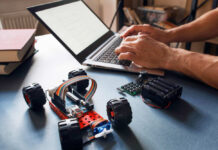Introduction
The first years of a child’s life are critical for their development, and early childhood education plays a vital role in shaping their future. This article will provide a comprehensive guide to early childhood education, highlighting the latest trends and research.
Learning Through Play: The Importance of Movement and Creativity
Children are naturally curious and love to explore their environment through movement and play. Learning through play is essential in an early childhood education as it allows children to develop cognitive, physical, and social-emotional skills. Movement and creativity are important components of play-based learning as they stimulate children’s imagination and allow them to experiment with different ideas and concepts.
Physical activities such as running, jumping, climbing, and dancing not only enhance children’s gross motor skills but also help to develop their coordination and balance. Engaging in creative activities such as drawing, painting, and storytelling allows children to express themselves and develop fine motor skills. When children engage in open-ended play, they learn to problem-solve, think critically, and develop their creativity.
The Digital Age: Integrating Technology in Early Childhood Education
As technology evolves, digital tools such as software to manage childcare centers in early childhood education have become more prevalent. While some may view this integration with apprehension, technology can enhance the learning experience and engage young learners in new and exciting ways when used effectively.
One example of technology integration in early childhood education is the use of educational apps and games. These apps can provide interactive experiences and encourage children to learn and develop new skills while stimulating their curiosity and creativity. Not all apps and games are created equal, and parents and educators should carefully consider the quality and appropriateness of these digital tools.
Another way technology can be integrated into early childhood education is through the use of multimedia resources, such as videos and digital books. These resources can bring new stories and concepts to life, providing children with a more immersive learning experience. Additionally, technology can be used to connect children with experts in various fields through virtual field trips and online resources.
While technology can be a valuable tool, it is essential to strike a balance between digital and non-digital learning experiences. It is also crucial to ensure that technology supports, rather than replaces, important aspects of early childhood education, such as social interaction and physical activity.
Beyond the ABCs: Early Literacy and Numeracy in Early Childhood Education
As important as play and technology are, early literacy and numeracy must also be given priority in early childhood education. Literacy and numeracy skills provide a foundation for academic success in later years.
The focus should be on something other than formal instruction but on providing opportunities for young children to develop these skills through fun and engaging activities. Teachers can incorporate language and math into daily routines, such as reading stories, counting objects, and singing songs with numbers. Parents can also play an important role in promoting literacy and numeracy by reading to their children and engaging in math activities.
Additionally, it is important to recognize that children learn at different rates and in different ways. Early childhood educators should be trained to recognize the individual learning styles of each child and tailor their teaching accordingly. This may involve using different teaching strategies, such as visual aids or hands-on activities.
It is also important to create a literacy-rich environment in the classroom, with plenty of books, writing materials, and other language-related resources available for children to explore. Numeracy skills can be developed through activities that involve counting, sorting, and measuring objects.
The Great Outdoors: Nature-Based Learning in Early Childhood Education
Incorporating nature-based learning into early childhood education has been gaining popularity in recent years. This approach incorporates natural elements such as plants, animals, and weather patterns into the learning environment to encourage exploration, inquiry, and problem-solving. Nature-based learning has been shown to enhance children’s cognitive development, social-emotional skills, and physical health.
One of the key benefits of nature-based learning is the opportunity for children to engage in unstructured, open-ended play. Studies have shown that children who spend more time in natural settings engage in more creative, imaginative play, which can help develop their problem-solving and critical-thinking skills.
In addition to promoting creativity and problem-solving, nature-based learning supports physical development. Outdoor play allows children to engage in physical activities, which can help develop their gross motor skills and promote overall health and wellness.
Nature-based learning can also teach children about science and the natural world. Children can learn about plant and animal life cycles, weather patterns, and other natural phenomena through hands-on experiences and observation.
Assessing Young Learners: Understanding Development and Supporting Growth
As parents and educators, it is essential to understand the development of young learners and provide them with the necessary support to ensure optimal growth. While some traditional assessments, such as standardized tests, are commonly used to evaluate children’s learning, alternative methods have proven more effective in early childhood education.
Observation is one of the best ways to assess young learners. Observing children’s behaviors, interests, and abilities in different contexts and settings is essential to develop a comprehensive understanding of their strengths and challenges. By carefully observing children, parents and educators can identify their unique learning styles and design appropriate learning experiences tailored to their needs.
Assessments should also be ongoing and integrated into everyday activities. Daily routines such as meal times, playtime, and storytelling provide opportunities for observation and assessment. By embedding assessments into these activities, educators and parents can provide continuous feedback and adjust learning experiences accordingly.
It is also crucial to involve parents and caregivers in the assessment process. By sharing observations and insights with parents, educators can collaborate with families to develop individualized learning plans that support children’s growth and development.
Conclusion
It is important for parents, educators, and policymakers to recognize the value of early childhood education and provide the necessary resources and support to make it accessible to all children.
We must continue to prioritize early childhood education and strive to create learning environments that foster curiosity, exploration, and a love of learning. By working together, we can help raise the next generation of creative, innovative, and compassionate leaders who will shape the world for years to come.
















